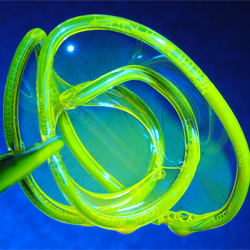Soap films with complex shapes shed light on the formation of mathematical singularities, which occur in a broad range of fields.
Soap films with complex shapes shed light on the formation of mathematical singularities, which occur in a broad range of fields.
This is an example of experimental mathematics, in the sense that we are using laboratory studies to inform conjectures on mathematical connections
Raymond Goldstein
The way in which soap films collapse and re-form when twisted or stretched could hold the key to predicting the formation and location of mathematical singularities, which can be seen in the motion of solar flares and other natural phenomena.
Research on the processes by which soap films undergo transitions from one stable state to another has led to conjectures on the nature and location of the singular events that occur during the change of form, connecting two previously separate areas in mathematics.
In mathematics, singularities occur when an equation or surface breaks down and ‘explodes’. In surfaces such as soap films, singularities occur when the surface collides with itself, changing shape in the blink of an eye.
Researchers from the University of Cambridge have shown that identifying a special type of curve on the surface can help predict where these singularities are likely to occur in soap films, which could in turn aid in the understanding of singularities in the natural world. The results are published in the journal Proceedings of the National Academy of Sciences (PNAS).
We are all familiar with the simplest soap films, which are formed by dipping a wire loop into a soap solution: the flat surface that spans the wire and the bubbles which are formed when we blow on the film. With suitably shaped wires however, much more complex structures can be formed, such as Möbius strips.
All static soap films are ‘minimal surfaces’, for they have the least area of all possible surfaces that span a given wire frame.
What is less understood are the dynamic processes which occur when a minimal surface like a soap film is made unstable by deforming the supporting wire. The film typically moves in a fraction of a second to a new configuration through a singular point, at which the surface collides with itself and changes its connectivity.
These kinds of violent events also occur in the natural world – in fluid turbulence and in the motion of solar flares emanating from the sun – and one of the great challenges has been to predict where they will occur.
In research supported by the EPSRC, a team from the Department of Applied Mathematics and Theoretical Physics attempted to understand how to predict where the singularity will occur when soap films are twisted or stretched to a point of instability. For example, it is well-known that the surface spanning two separate wire loops will collapse to a singularity in between the loops.
In previous work, the group had shown that Möbius strip singularity occurs not between the loops but at the wire frame, where there is a complex rearrangement of the surface. “What was unclear was whether there was an underlying mathematical principle by which this striking difference could be explained,” said Professor Raymond Goldstein, who collaborated with Dr Adriana Pesci, Professor Keith Moffatt, and James McTavish, a maths undergraduate, on the research.
The team recognised that a geometric concept known as a systole might be the key to understanding where singularities will occur. A systole is the length of the shortest closed curve on surface that cannot be shrunk to a point while remaining on the surface. An example of this is found on a bagel, where the shortest such curve encircles the bagel like a handle. Mathematicians have studied the geometric properties of these curves in recent decades, establishing constraints on the relationship between the length of a systole and the area of the surface on which they lie.
Using new laboratory experiments and computations, the researchers found evidence that the ultimate location of the singularities that occur when soap films collapse can be deduced from the properties of the systole. If the systolic curve loops around the wire frame, then the singularity occurs at the boundary, while if there is no such linking the singularity occurs in the bulk.
“This is an example of experimental mathematics, in the sense that we are using laboratory studies to inform conjectures on mathematical connections,” said Professor Goldstein. “While they are certainly not rigorous, we hope they will stimulate further research into this new, developing area.”
The text in this work is licensed under a Creative Commons Licence. If you use this content on your site please link back to this page. For image rights, please see the credits associated with each individual image.


